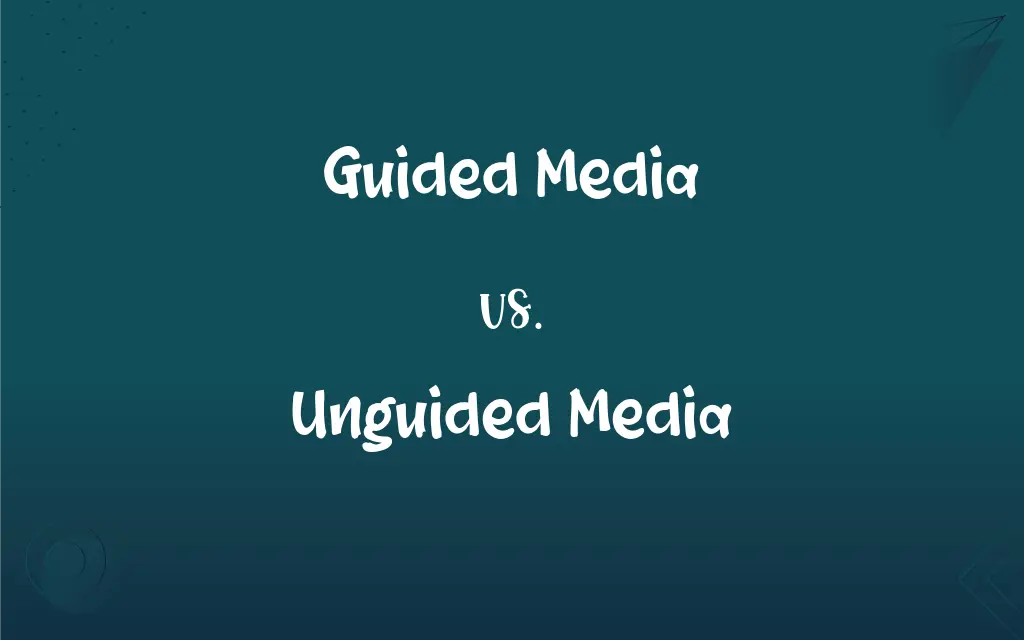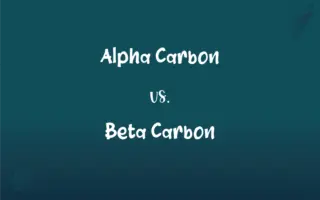Guided Media vs. Unguided Media: What's the Difference?
Edited by Aimie Carlson || By Janet White || Published on February 16, 2024
Guided media involves data transmission through physical means like cables, while unguided media transmits data wirelessly through air or space.

Key Differences
Guided media, also known as wired or bounded media, involves transmitting data over physical cables or wires. Unguided media, also known as wireless or unbounded media, uses electromagnetic waves for data transmission through air or space.
In guided media, data travels through a solid medium such as copper wires, fiber optic cables, or coaxial cables. Unguided media, on the other hand, utilizes air, vacuum, or the environment as its transmission medium, using radio, microwave, or infrared signals.
Guided media is typically used for network communications within a confined geographical area, such as within a building or campus. Unguided media is more suitable for broader range communication, including satellite and cellular networks.
The data transmission in guided media is generally more secure and less prone to external interferences compared to unguided media. However, unguided media offers more mobility and convenience as it does not rely on physical connections.
Installation and maintenance of guided media can be more complex and costly due to the need for physical infrastructure. Unguided media, while offering ease of deployment, faces challenges like signal range limitations and susceptibility to environmental factors.
ADVERTISEMENT
Comparison Chart
Transmission Medium
Physical cables (e.g., copper, fiber)
Air, space (radio, microwave signals)
Mobility
Limited mobility; fixed infrastructure
High mobility; no physical constraints
Security
Generally more secure
More susceptible to interference
Suitable Environments
Confined areas (buildings, campuses)
Open and larger areas
Installation and Maintenance
More complex and costly
Easier deployment; environmental challenges
ADVERTISEMENT
Guided Media and Unguided Media Definitions
Guided Media
Transmission of data through physical cables.
Ethernet uses guided media for local area networking.
Unguided Media
A non-physical medium for communication and networking.
Cellular networks rely on unguided media for mobile communication.
Guided Media
Physical pathways for digital signal transmission.
Coaxial cables are guided media used for cable television.
Unguided Media
Wireless transmission of data through air or space.
Wi-Fi networks utilize unguided media for internet access.
Guided Media
Data transmission through solid conductors.
Copper wires are a common form of guided media in telecommunication.
Unguided Media
Communication without the use of physical cables.
Bluetooth devices communicate using unguided media.
Guided Media
A physical medium for networking and communication.
Fiber optic cables are a type of high-speed guided media.
Unguided Media
Transmission of data via electromagnetic waves.
Satellite communication is an example of unguided media.
Guided Media
Wired communication channels in networking.
Our office network relies on guided media for secure data transfer.
Unguided Media
Data transmission in open environments without cables.
Radio broadcasts are transmitted through unguided media.
FAQs
Is guided media suitable for long-distance communication?
It can be used but may be less practical compared to unguided media for very long distances.
What are examples of guided media?
Examples include fiber optic cables, coaxial cables, and twisted pair cables.
Can guided media be used outdoors?
Yes, but it requires protective cabling and infrastructure.
Is guided media more secure than unguided media?
Generally, yes, due to its physical containment.
How does guided media handle interference?
Guided media is generally less susceptible to external interference.
What are examples of unguided media?
Examples include Wi-Fi, satellite, and cellular networks.
Do guided media require a direct line of sight?
No, guided media do not require a line of sight for transmission.
Which media type is faster, guided or unguided?
Guided media, like fiber optics, typically offer higher speeds.
Can unguided media be used for indoor communication?
Yes, it's commonly used for indoor wireless networks.
How does weather affect unguided media?
Adverse weather can interfere with wireless signal transmission.
Does unguided media require a line of sight?
It depends on the technology; some, like infrared, do require a line of sight.
Is unguided media affected by physical barriers?
Yes, physical barriers can impact signal strength and quality.
Can guided media be easily scaled?
Scaling guided media often requires additional physical infrastructure.
How do guided and unguided media compare in terms of latency?
Guided media usually have lower latency compared to unguided media.
How do environmental factors affect guided media?
Environmental factors like moisture and temperature can affect cable performance.
What are the maintenance considerations for guided media?
Guided media requires regular maintenance of physical cables and connectors.
Is unguided media more flexible than guided media?
Yes, due to its wireless nature and ease of deployment.
Can unguided media support high data rates?
Yes, especially with advancements in wireless technology.
Are guided media installations more costly?
Typically, yes, due to the physical infrastructure required.
Can both guided and unguided media be used in a single network?
Yes, many networks combine both for optimal performance and flexibility.
About Author
Written by
Janet WhiteJanet White has been an esteemed writer and blogger for Difference Wiki. Holding a Master's degree in Science and Medical Journalism from the prestigious Boston University, she has consistently demonstrated her expertise and passion for her field. When she's not immersed in her work, Janet relishes her time exercising, delving into a good book, and cherishing moments with friends and family.
Edited by
Aimie CarlsonAimie Carlson, holding a master's degree in English literature, is a fervent English language enthusiast. She lends her writing talents to Difference Wiki, a prominent website that specializes in comparisons, offering readers insightful analyses that both captivate and inform.






































































